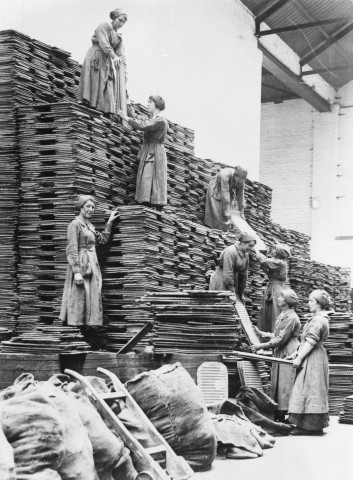New Photographic Display Outside IWM North
Launching the 2014 First World War Centenary programme at IWM North
From 18 January 2014 – Free Entry; Donations Welcome
Exploring how the First World War changed the society we live in today, a new external photographic display at IWM North, part of Imperial War Museums, in Manchester, reveals images of women working in industry during the conflict.
As IWM builds towards a major programme of events and displays commemorating the First World War Centenary, six images by official First World War photographer G P Lewis are being unveiled in huge, 5 metre high frames, outside IWM North, on the Quays in Manchester.
George Parham Lewis, an official photographer of the home front, specialised in documenting heavy industry and photographed women workers in the glass, vehicle and food industries.
The images in the free IWM North display document women’s vital contribution to the war effort in factories across the North West of England almost 100 years ago.
Taken from IWM’s renowned Photographic Archive, the images were jointly commissioned by IWM and the Ministry of Information, demonstrating the wide range of roles performed by women during the First World War.
Visitors are invited to contact IWM North on Twitter @I_W_M #IWMNorth or Facebook.com/iwm.north if they recognise family members in any of GP Lewis’ photographs on display.
Graham Boxer, Director of IWM North, said: ‘The First World War was a major turning point that shaped the world we live in today, including the roles of women in society. These six powerful images depict women at work during an extraordinary time. It is a fitting start towards a major programme of exhibitions, displays and events marking the First World War Centenary at IWM North. Later this year we will open the largest exhibition ever created exploring the role of the North West of England during the First World War.’
The Women and Industry display opens on 18 January, while IWM North’s major exhibition marking the centenary, From Street To Trench: A War that Shaped a Region, will open on 5 April. For more information, visit www.iwm.org.uk
GP Lewis’ photographs depict the following scenes of woman and industry in the North West during the First World War:
- Women workers in an Oil and Cake factory having tea, Lancashire, 1918. Oil cakes were used to feed cattle
- Female worker in Charles Macintosh and Sons’ Ltd rubber factory, Manchester, 1918
- Female glass worker carrying a tube of rolled glass at Pilkington Glass Ltd., St Helen’s, 1918. The company still exists today
- Women workers stacking oil cakes at an Oil and Cake factory, Lancashire, 1918
- Women working in an asbestos factory, Lancashire, 1918. Asbestos, now recognised as a dangerous material, was used in many different ways such as in buildings and enginesWomen workers operating a grain elevator at the mills of Messrs. Rank & Sons in Birkenhead, 1918


